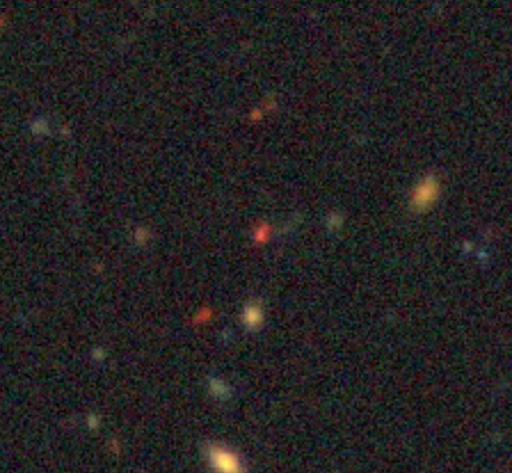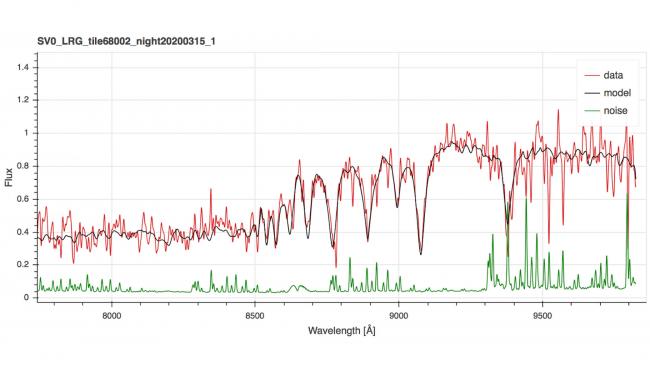Dark Energy Spectroscopic Instrument (DESI)
The Dark Energy Spectroscopic Instrument (DESI) consortium is conducting a five-year survey to map the large-scale structure of the Universe over one-third of the sky and 11 billion years of cosmic history, aiming to study the physics of dark energy.

This target was selected from the Data Release 8 of the DESI Legacy Imaging Surveys (Dey et al., AJ, 157, 168, 2019); the object is shown in the center of the small (1’) image here, formed from the g, r, and z-band images.
The Dark Energy Spectroscopic Instrument (DESI) consortium will conduct a massive redshift survey to map the large-scale structure of the Universe over one-third of the sky and 11 billion years of cosmic history. DESI is designed to measure the impact of dark energy, through the baryon acoustic oscillations and galaxy redshift-space distortions. The 5-year DESI survey will begin in 2021 and acquire redshifts of about 35 million galaxies and quasars, as well as millions of stars.
Prof. Daniel Eisenstein served as co-Spokesperson of the DESI collaboration from 2014 to 2020 and is heavily involved in the target selection, cosmological simulation, and large-scale structure analyses of the data set. Prof. Douglas Finkbeiner aims to use DESI to study the Milky Way galaxy through its stars and dust. For both, the DESI data set provides a state-of-the-art opportunity for the development of statistical methods for astrophysics.
The DESI instrument features 5000 robotically positioned fibers covering an 8 square degree focal plane on the 4-meter Mayall telescope at Kitt Peak National Observatory. The fibers feed an array of ten three-arm moderate-resolution spectrographs of high efficiency.
Prior to the start of spectroscopy, the DESI collaboration led the execution of the Legacy Survey, an imaging program that resulted in deep imaging of about half of the sky in three optical bands plus co-reduction with 7 years of infrared imaging from the WISE satellite mission.
The data releases from the Legacy Survey are available here.

The infrared DESI spectrum and Legacy Survey image of a redshift 1.286 post-starburst galaxy easily revealing the distinctive Balmer-line signature. This galaxy is magnitude 19.9 (AB) in the z-band, about a factor of 2 brighter than the planned flux limit for DESI luminous red galaxy selection. DESI observed this target for 45 minutes on March 15. The spectrum has been smoothed for presentation. Adapted from https://www.desi.lbl.gov/2020/04/02/blog-post-1/.
Harvard is a member of the DESI collaboration. DESI is supported by the Director, Office of Science, Office of High Energy Physics of the U.S. Department of Energy under Contract No. DE–AC02–05CH1123, and by the National Energy Research Scientific Computing Center, a DOE Office of Science User Facility under the same contract; additional support for DESI is provided by the U.S. National Science Foundation, Division of Astronomical Sciences under Contract No. AST-0950945 to the NSF’s National Optical-Infrared Astronomy Research Laboratory; the Science and Technologies Facilities Council of the United Kingdom; the Gordon and Betty Moore Foundation; the Heising-Simons Foundation; the French Alternative Energies and Atomic Energy Commission (CEA); the National Council of Science and Technology of Mexico; the Ministry of Economy of Spain, and by the DESI Member Institutions. The collaboration is honored to be permitted to conduct astronomical research on Iolkam Du’ag (Kitt Peak), a mountain with particular significance to the Tohono O’odham Nation.
- Quasars & Other Active Black Holes
- Medical Applications
- Extragalactic Distance Scale
- Dark Energy and Dark Matter
- Early Universe
- Galaxy Clusters
- Galaxy Formation and Evolution
Experts
- Daniel Eisenstein
- Douglas Finkbeiner
- Sownak Bose
- Tanveer Karim
- Claire Lamman
- Sihan Yuan
- Nina Maksimova
- Boryana Hadzhiyska